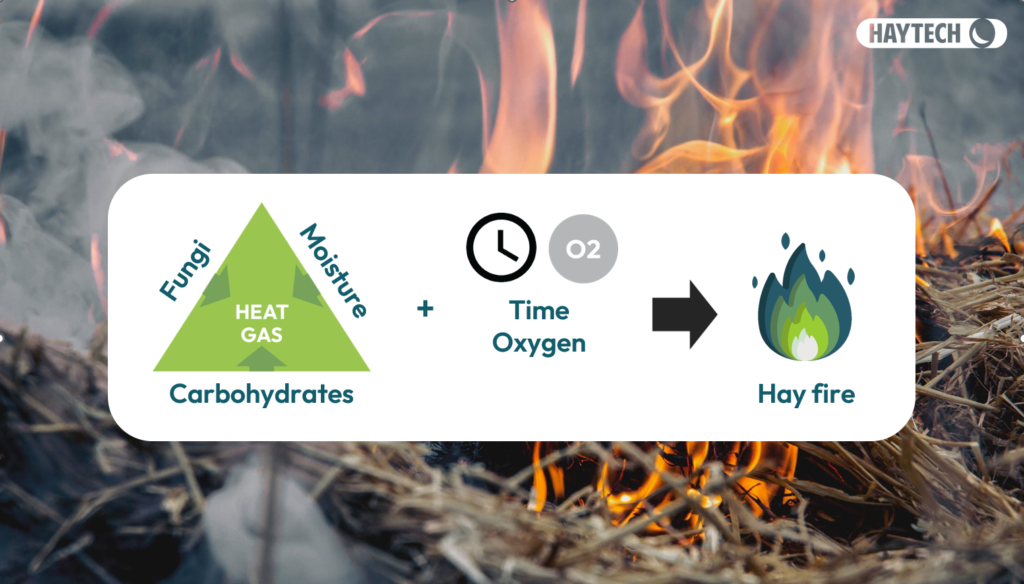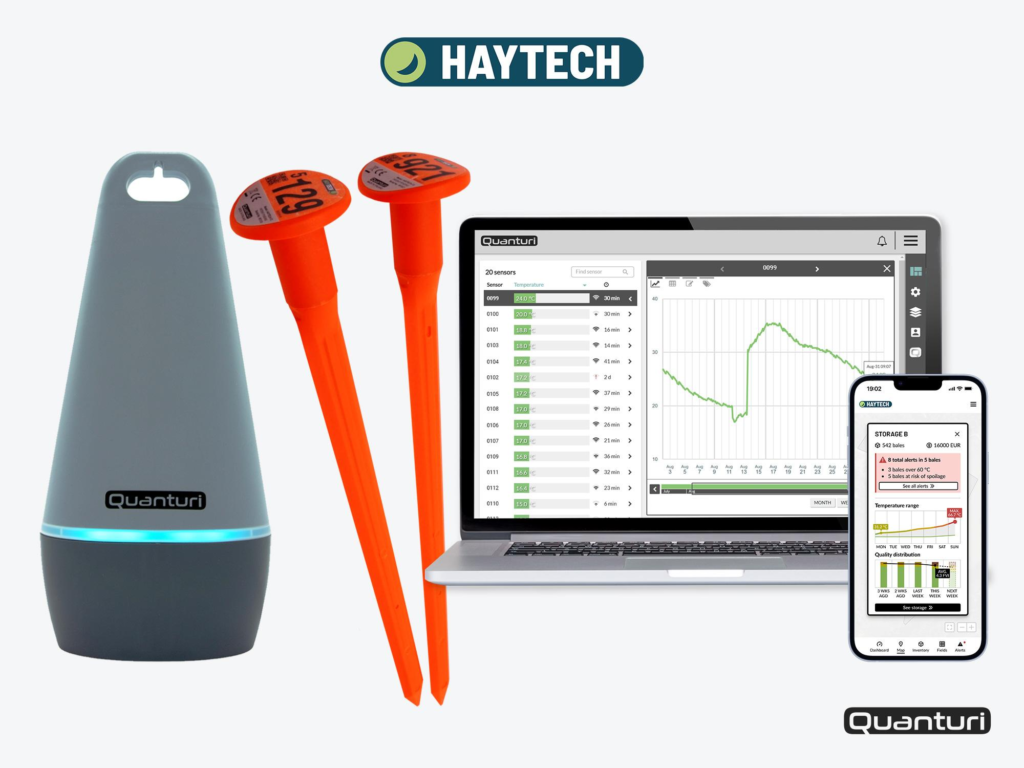Hay spontaneous combustion
Have you ever heard about hay bales catching fire all on their own? It’s called hay bales spontaneous combustion. Sounds strange, right? In this blog post, we’ll explain the science behind this mysterious occurrence, exploring the role of moisture in hay bales spontaneous combustion and the crucial need for temperature monitoring to prevent potentially disastrous fires.
Biological activity and bacterial growth combined can raise the temperature even in the driest hay bales. However, when hay is tightly packed and enough moisture gets in, the conditions may be right for spontaneous combustion of hay bales.
Table of Contents
What causes spontaneous combustion in hay bales?
Metabolic activity during drying
When the hay is harvested and baled, the grass continues to undergo metabolic processes for a few days before fully drying out. During this period, the grass consumes some sugars, releasing heat, water, and carbon dioxide.
Role of aerobic fungi and bacteria
As a natural part of this process, aerobic fungi and bacteria present on the grass become active, consuming oxygen, and further breaking down sugars and nutrients, generating additional heat and water as by-products.
Bacteria respiration
Bacteria thrive in environments where there is sufficient glucose, a simple sugar commonly found in plants. They break down glucose through respiration to obtain energy. Aerobic bacteria fully oxidize glucose, converting it into carbon dioxide, water, and usable energy.
Anaerobic activities in storage
Once the bales are typically placed in storage, the enclosed environment becomes conducive to anaerobic activities. This environment allows a variety of microorganisms to thrive, leading to increased heat generation and the production of flammable gases.
Even after the hay is cut and baled, plant cells remain metabolically active, continuing to respire much like bacteria. They convert glucose into carbon dioxide, water, and energy, releasing heat in the process.

What is the recommended moisture concentration to minimize the risk of hay spontaneous combustion?
Ideal moisture content for baling and storing hay
With an appropriate moisture concentration, according to both the University of Minnesota Extension and the Washington State University Extension, the ideal moisture content for baling and storing is 15% moisture or less.
Risks of high moisture levels
When moisture levels climb above 15%, thermophilic bacteria, which thrive in warm conditions, start to flourish. They have enough water to dissolve and absorb nutrients, and they reproduce by splitting into two through binary fission when conditions are just right.
Detecting mold
Be alert for the growth of mold, which can produce a distinct, sharp odor, like tobacco and rotten apples. If you notice any of these warning signs, take immediate action to prevent a potential hay fire.
Bacterial growth and heat generation
The population of a community of bacteria can double in about 10 minutes. As each hungry little cell consumes a bit of the glucose, which is everywhere around them, the amount of heat generated can increase quickly. Remember, even dew and fog can increase the moisture content of hay.
Prevention measures against hay bales spontaneous combustion and fires

HAYTECH wireless temperature monitoring system
Detect and monitor the risk of hay spontaneous combustion with the industry’s leading smart hay monitoring system.
How to prevent hay from spontaneous combustion or catching fire?
To prevent hay fires, it’s important to keep a close eye on the temperature inside the bales or stacks, especially when storing hay indoors. Look out for signs like steam rising from the bales, but don’t rely solely on that. If you see condensation on the floor and eaves of the barn, it’s a sign of steam and heat build up.
Use manual probes to monitor hay bales temperature
Experts recommend regularly monitoring internal temperatures, even in the absence of visible signs. However, the use of manual probes every second day is time-consuming and demands good access to most of the bales to be reliable. This should be done for at least 6 months after storing the bales. A lot of time (thus money) is wasted in the process of incomplete information.
Use wireless temperature probes with sms alerts
The hay monitoring system HAYTECH, equipped with wireless temperature probes, simplifies the task by providing real-time temperature data direct to mobile phones, desktops, and laptops. With easy installation and plug-and-play functionality, manual temperature checks are no longer necessary.
In addition, users can set temperature thresholds and receive alerts, allowing for proactive management. Moreover, the system’s advance features, such as Feed Value Indicator, enable monitoring of energy and protein loss due to temperature fluctuations, empowering farmers with greater control over hay and feed management.
Calling fire department
Even without visible flames at these high temperatures, experts advise calling the fire department first. Then, if possible, without risking injury, move nearby items and animals away. Bales that are not on fire can be relocated, and it’s recommended to spread them out to promote airflow and dissipate heat. However, be cautious, as moving bales introduces more oxygen to potentially burning bales
Frequently asked questions
When the internal temperature of a hay bale rises to 130-175°F (54-79°C) due to microbial activity, an exothermic chemical reaction can occur, causing the temperature to climb even higher. This can escalate to the ignition point, between 448-527°F (231-275°C), potentially leading to combustion.
Hay can be highly combustible, especially when it is wet. Moist hay continues to respire, generating heat that can lead to spontaneous combustion. The risk is particularly high in the first two to six weeks after baling and storage if moisture levels are elevated.
When hay’s internal temperature exceeds 130°F (55°C), a chemical reaction occurs, releasing flammable gases that can ignite. The majority of hay fires happen within six weeks of baling.
Hay can combust due to heat build-up caused by high moisture levels and microbial activity. The HAYTECH system monitors hay moisture and temperature in real-time, alerting you to unsafe conditions before they escalate.
Yes, If hay isn’t fully dry when baled, it begins to respire, breaking down sugars and releasing moisture and heat. Molds and bacteria within the bale can amplify moisture and heat production, causing temperatures to rise. This causes hay bales to self-ignite.
Fire can ignite in loose hay, small bales, large bales, or hay stacks, whether stored indoors or outdoors. Regardless of the location or storage method, the primary cause is heat generated by microbes activity. Freshly cut forage is still biologically active, making it particularly susceptible to heat build-up and combustion.
Hay baled or stacked with moisture levels above 15% can reach temperatures high enough to cause heat damage through the browning reaction. Large bale systems are particularly susceptible to this, as heat is released more slowly than in smaller bales, increasing the risk of damage.
Authors

Marie Huyghe
Author
Agronomist Quanturi Oy

Hassan Ali
Reviewer
Performance Marketer Quanturi Oy